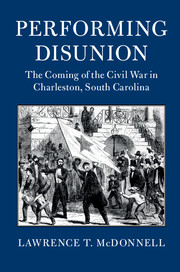2 - Wayward Loyalties
from CONTEXT: THE CITADEL BESIEGED
Published online by Cambridge University Press: 08 June 2018
Summary
Approached by sea, antebellum Charleston presented visitors with a series of memorable and forbidding scenes quite unlike the cheery landscapes contemporary artists painted. In John William Hill's 1855 lithograph, Charleston was White Point Gardens and mansions lining the Battery, broad Meeting Street sprinkled with carriages and couples taking the air, sailboats scudding along the shore. The bird's- eye view the artist adopted mingled realism with a more fanciful perspective, promising verisimilitude yet both exaggerating and suppressing details. The wharves and warehouses that crowded the city's eastern edge are barely visible in Hill's picture. The shipping that was Charleston's raison d’être is pushed to the margins. No plume of smoke rises from the railroads, foundries, and factories concentrated north of the city market: they are invisible here. Stare hard at the center of the image, just above the Four Corners, and a procession of some sort stands out, though what it portends remains uncertain. There is no bustle or throng in these streets. All is measured, tranquil, and bathed in the light of a cloudless sky. The scene is an oversized tourist postcard, advertising a seaside Neverland.
It was an idealized image local elites strove to cultivate, a comforting illusion of wealth and ease uncomplicated by commerce or production that Northern and foreign visitors parroted in the travel accounts they penned. Charleston was “quite a bandbox city,” actor Louis Tasistro declared, “so neat, spruce, and new- looking, one might suppose it just taken, ready- cut, out of the quarry.” Touring Charleston in 1854, British aristocrat Clara Bromley especially approved its “wide, clean, and airy” streets. A year later, Lillian Foster admired the “retirement” and “repose” of the city's houses, “which makes them look more like the splendid palaces of opulence and rank, surrounded by the gardens of fashion, than the habitations of a commercial city.” Even abolitionist James Redpath could not resist Charleston's “thoroughly English appearance and construction, its old- time customs, its genial climate.”
Charlestonians were “a very social, kind, happy people,” considered Boston's Louisa Minot, “and do not nail themselves down the whole day to business …
- Type
- Chapter
- Information
- Performing DisunionThe Coming of the Civil War in Charleston, South Carolina, pp. 33 - 49Publisher: Cambridge University PressPrint publication year: 2018



